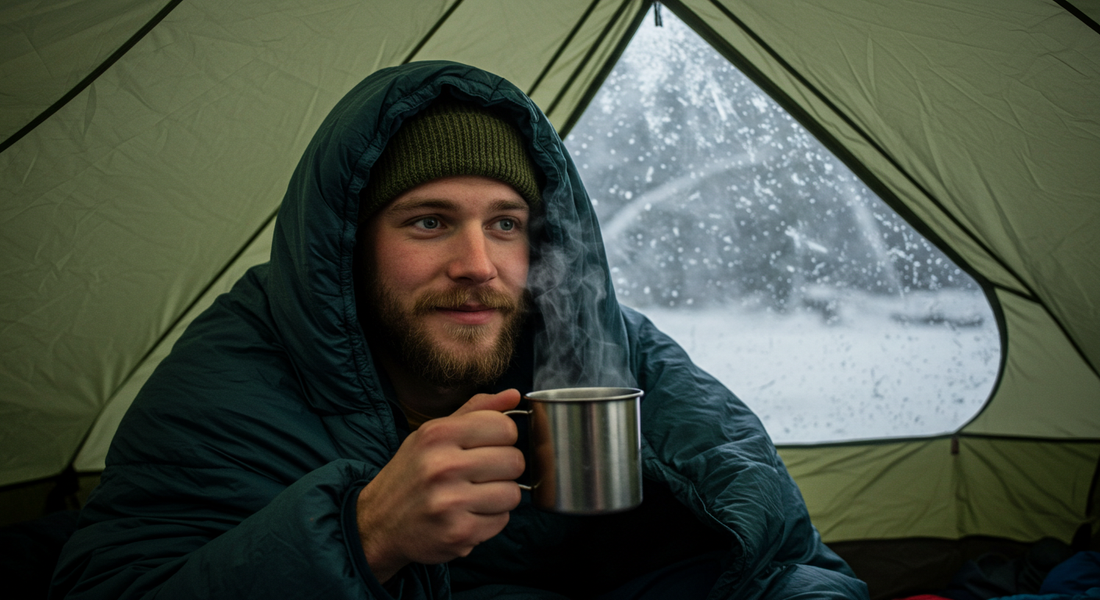
Cold-Weather Camping: How to Stay Warm and Sleep Better Outdoors
Share
1. Introduction: The Art of Winter Camping
Winter camping is both beautiful and challenging — a serene landscape of frosted pines, crisp air, and starlit skies, balanced with the need to stay warm and comfortable. For those who love exploring year-round, the key to enjoying the cold is mastering warmth management.
At Packstead, we understand that cold-weather comfort doesn’t just happen — it’s built through smart layering, insulation, and gear designed to perform when temperatures drop. In this guide, we’ll cover how to stay warm, sleep well, and make your winter camping experience one of calm and confidence.
2. Understanding Cold Weather Challenges
Camping in cold temperatures presents unique challenges: heat loss, moisture buildup, and limited daylight hours. The body naturally loses warmth through conduction, convection, and radiation — meaning your sleep setup, clothing, and camp habits all play critical roles in preserving heat.
The goal is simple: retain warmth, block wind, and stay dry.
3. Build a Warm Sleep System
A well-designed sleep system is your best defense against the cold. It’s not just about your sleeping bag — every layer counts.
1. Insulated Sleeping Pads:
Cold seeps from the ground into your body if your pad lacks insulation. Choose a high R-value (4.0 or higher) for winter conditions. Double up pads if necessary — a foam pad under an air pad creates both insulation and cushioning.
2. Cold-Rated Sleeping Bags:
Invest in a bag rated for at least 10–15°F lower than the expected nighttime temperature. Down insulation offers the best warmth-to-weight ratio, while synthetic insulation maintains performance even when damp.
3. Ultralight Inflatable Camping Pillows:
A small detail that makes a big difference — an inflatable pillow keeps your neck elevated and prevents contact with the cold tent floor. Opt for pillows with soft, insulated fabric surfaces for added warmth.
4. Sleeping Bag Liners:
A liner adds up to 10°F of extra warmth, while keeping your bag cleaner and more comfortable. Fleece or thermal liners work best for cold nights.
4. Layering for Success
The layering principle isn’t just for hiking — it applies to sleeping too.
- Base Layer: Moisture-wicking and snug. Choose merino wool or synthetic materials.
- Mid Layer: Fleece or down for insulation.
- Outer Layer: A light shell or insulated jacket for additional warmth if needed.
Avoid cotton — it traps moisture and steals warmth from your body.
Before bed, change into dry clothes (even dry socks) to eliminate residual sweat from daytime activity.
5. Mastering Tent Insulation
A tent can lose heat rapidly, especially in windy or snowy environments. To maintain warmth:
-
Choose a Four-Season Tent: Built to withstand snow and retain heat better than three-season designs.
-
Use a Tent Footprint: Adds a barrier between cold ground and your sleeping area.
-
Seal Gaps: Close ventilation flaps partially to block drafts — but don’t eliminate airflow completely (to prevent condensation).
-
Add a Reflective Blanket or Mylar Layer: Placed under your sleeping pad, it reflects body heat back to you.
6. Smart Campfire and Heat Management
Campfires are great for warmth and morale, but they’re not always available or sustainable. Supplement your campfire with smart heat strategies:
- Hot Water Bottle Trick: Fill a durable bottle with hot water before bed and place it inside your sleeping bag. It can stay warm for hours.
- Insulated Tent Heaters: For basecamp setups, a portable heater designed for tents adds reliable warmth — always ensure proper ventilation for safety.
- Stay Active Before Bed: Light movement like stretching or walking raises body temperature naturally before you settle into your bag.
7. Moisture Control Is Everything
Even the warmest setup fails if it gets damp. Condensation, sweat, and snowmelt are your biggest enemies.
- Keep wet gear outside the sleeping area in a vestibule or dry bag.
- Ventilate your tent slightly to let humid air escape.
- Use waterproof stuff sacks for sleeping bags and clothes.
- Never breathe into your sleeping bag — moisture builds up quickly that way.
8. Nutrition and Hydration for Warmth
Your body is your furnace. Keeping it fueled helps maintain heat overnight.
- Eat a high-calorie dinner with carbs and fats to keep energy levels stable.
- Stay hydrated, but avoid excessive liquids before sleep to reduce midnight cold exits.
- Warm drinks like tea or broth help raise your core temperature before bed.
9. Safety and Preparedness
Cold-weather camping can be deeply rewarding, but preparation is non-negotiable. Always pack:
- Extra thermal layers and socks
- Hand warmers or reusable heat packs
- Emergency blankets
- A first aid kit
- Reliable communication tools (radio, satellite phone, or GPS)
Check the weather forecast and be aware of frostbite and hypothermia signs — prevention is always easier than treatment.
10. The Joy of Winter Nights
There’s a unique calm in winter camping — the still air, the soft crunch of snow, and the clarity of stars. When you’re warm and well-rested, you can truly appreciate nature’s quiet side.
By building a reliable cold-weather sleep system, dressing smartly, and maintaining dryness, you can sleep deeply even when the mercury drops.
At Packstead, we believe the best adventures don’t stop when the temperature falls — they simply become more memorable.
